10 Beautiful Places To Visit In Rome
By: Priyanka Maheshwari Mon, 12 June 2023 12:20:08
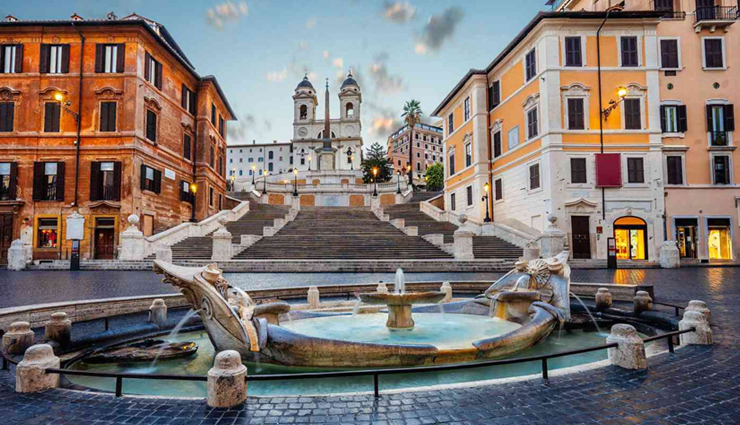
Rome is a city that never fails to captivate its visitors with its timeless beauty. From ancient ruins to magnificent churches, from grand squares to peaceful gardens, Rome offers a plethora of beautiful places to explore. Whether you're fascinated by history, art, or simply the charm of an old city, Rome will leave an indelible mark on your heart. So, pack your bags, immerse yourself in the rich history, and discover the 10 beautiful places that make Rome an unforgettable destination.
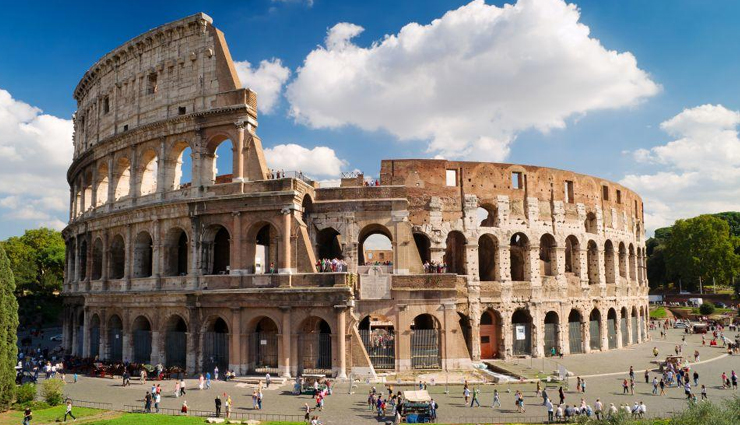
# The Colosseum
No visit to Rome is complete without stepping foot inside the iconic Colosseum. Visitors to Rome have the opportunity to explore the Colosseum and learn about its fascinating history. Inside, you can witness the grandeur of the amphitheater, walk through the ancient corridors, and even visit the museum dedicated to the Colosseum's history. The site offers insights into the gladiatorial contests, Roman society, and the architectural brilliance of the era.
Construction of the Colosseum began in 72 AD under the Emperor Vespasian and was completed in 80 AD during the reign of his son, Titus. It was built as a gift to the Roman people and was used for various events, including gladiatorial contests, animal hunts, and public spectacles.
Architecture:
The Colosseum is an architectural marvel, known for its innovative design and engineering prowess. The elliptical-shaped amphitheater spans over 6 acres and could accommodate an estimated 50,000 to 80,000 spectators. It is made of concrete and stone, with a façade featuring three levels of arches, each adorned with columns of different architectural styles - Doric, Ionic, and Corinthian.
Features:
The Colosseum had a complex system of underground passages and chambers called the hypogeum, which was used to house animals, gladiators, and equipment for the shows. The arena floor, known as the "sandy" stage, was covered with sand to absorb the blood and ensure a better grip for the combatants.
Significance:
The Colosseum played a significant role in ancient Roman society, serving as a symbol of power and entertainment. It showcased the wealth and magnificence of the empire and provided a means to keep the population entertained. Gladiatorial fights and other spectacles held at the Colosseum were an integral part of Roman culture and served as a form of social control.
Preservation and Restoration:
Over the centuries, the Colosseum suffered damage from natural disasters, neglect, and human activities such as looting and vandalism. However, various restoration efforts have taken place to preserve this iconic structure. Today, the Colosseum stands as a UNESCO World Heritage site and attracts millions of visitors each year.
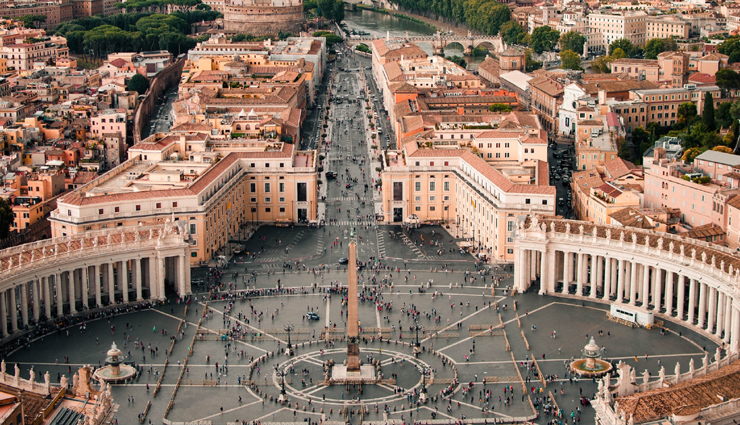
# The Vatican City
The Vatican City is an independent city-state and the spiritual and administrative headquarters of the Roman Catholic Church.The Vatican City was established in 1929 as a result of the Lateran Treaty, which resolved the "Roman Question" between the Kingdom of Italy and the Holy See. However, the Vatican's history dates back much further, with its roots in early Christianity and the Roman Empire.
The Vatican City is the smallest internationally recognized independent state in the world, covering an area of approximately 44 hectares (110 acres). It is located entirely within the city of Rome and is surrounded by walls. Within its borders, the Vatican contains numerous significant buildings and landmarks.
St. Peter's Basilica:
At the heart of the Vatican City is St. Peter's Basilica, the largest and most renowned church in the Catholic world. It is considered one of the holiest sites for Christians and is the burial place of Saint Peter, one of Jesus' twelve apostles. The basilica's architecture is a stunning example of Renaissance and Baroque styles, with magnificent artworks and intricate details throughout.
Vatican Museums:
The Vatican Museums house an extensive collection of art and historical artifacts spanning thousands of years. The collection includes works by masters such as Michelangelo, Raphael, and Leonardo da Vinci. One of the highlights is the Sistine Chapel, renowned for its ceiling frescoes painted by Michelangelo, including the famous "Creation of Adam."
Papal Palaces:
The Vatican City is also home to several papal palaces, including the Apostolic Palace, which serves as the official residence of the Pope. The Apostolic Palace contains the Papal Apartments, where the Pope resides, as well as various administrative offices.
St. Peter's Square:
Adjacent to St. Peter's Basilica is St. Peter's Square, a massive open plaza designed by Gian Lorenzo Bernini in the 17th century. The square features a central obelisk and is surrounded by colonnades, creating a dramatic and welcoming entrance to the basilica.
Papal Audience and Mass:
Visitors to the Vatican City have the opportunity to attend the Papal Audience and Papal Mass, where the Pope addresses the faithful and imparts blessings. These events offer a unique experience for pilgrims and tourists alike.
Importance to Catholicism:
The Vatican City holds immense significance for Catholics worldwide as the center of the Roman Catholic Church. It is the residence of the Pope, the spiritual leader of the Catholic Church, and a place of pilgrimage for millions of faithful each year.
Visiting the Vatican City:
The Vatican City welcomes visitors who wish to explore its rich cultural and religious heritage. Tourists can visit St. Peter's Basilica, the Vatican Museums, and other sites within the city-state. It is advisable to plan ahead and make reservations to avoid long queues, especially during peak tourist seasons.
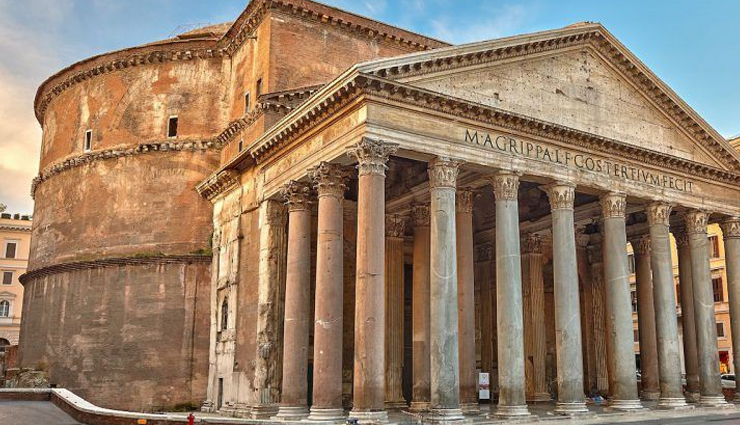
# The Pantheon
The Pantheon is a magnificent ancient Roman temple located in Rome. It is one of the most well-preserved and influential buildings from the Roman Empire. The Pantheon was originally built between 118 and 128 AD during the reign of Emperor Hadrian. However, it was constructed on the site of an earlier temple built by Marcus Agrippa in 27 BC. The current structure is the result of Hadrian's reconstruction.
Architecture:
The Pantheon is renowned for its architectural brilliance and innovative design. It is a circular building with a portico featuring massive granite Corinthian columns. The dome, which is the largest unreinforced concrete dome in the world, rises above the circular structure and is made of concrete mixed with lightweight volcanic stone. The oculus, a large circular opening at the center of the dome, provides natural light and a unique visual effect.
Purpose:
Originally, the Pantheon served as a temple dedicated to all the Roman gods. It was used for religious ceremonies, sacrifices, and as a place of worship. In 609 AD, the Pantheon was converted into a Christian church, now known as the Basilica of Santa Maria ad Martyres.
Interior:
The interior of the Pantheon is equally awe-inspiring. As you enter, you'll be struck by the vastness of the space and the sense of grandeur. The cylindrical main hall features marble floors, intricate details, and niches that once held statues of various deities. The coffered dome, adorned with rosettes, adds to the architectural beauty.
Tomb of Raphael:
One notable feature inside the Pantheon is the tomb of the renowned Italian painter Raphael. He was buried in the Pantheon in 1520, and his tomb serves as a tribute to his artistic contributions.
Significance:
The Pantheon is considered a remarkable achievement of Roman architecture and engineering. Its dome, in particular, has been a source of inspiration for countless architects throughout history. The building's design and construction techniques continue to fascinate scholars and visitors alike.
Visiting the Pantheon:
The Pantheon is open to the public and welcomes visitors from around the world. There are no entrance fees to explore the main area, and it remains an active place of worship. Visitors can marvel at the impressive architecture, appreciate the historical significance, and take a moment to soak in the tranquil atmosphere.
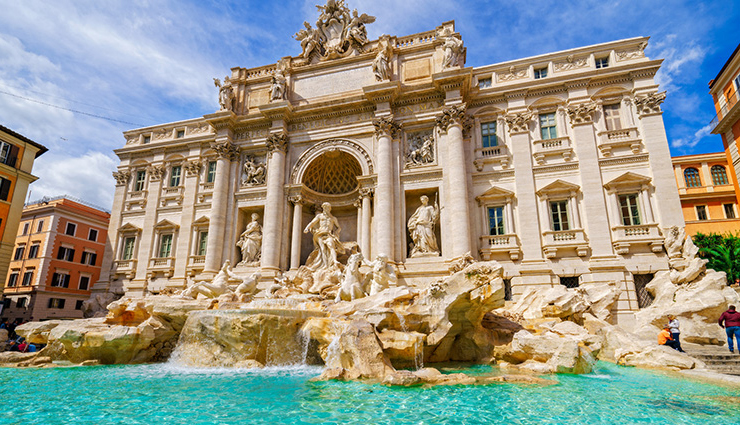
# Trevi Fountain
The Trevi Fountain, located in the heart of Rome is one of the most famous and enchanting fountains in the world. Known for its stunning Baroque design and rich history, the Trevi Fountain is a must-visit destination for travelers. The construction of the Trevi Fountain began in 1732, under the direction of architect Nicola Salvi, and was completed in 1762. The fountain was commissioned by Pope Clement XII and stands at the endpoint of the Aqua Virgo, an ancient Roman aqueduct that supplied water to Rome.
Design and Architecture:
The Trevi Fountain is a magnificent example of Baroque architecture. It features a large central statue of Oceanus, the god of the sea, riding a chariot pulled by two sea horses and two tritons. The sculptures represent the triumph of water and convey a sense of grandeur and motion. The fountain is adorned with intricate details, including depictions of various mythological figures and bas-reliefs.
The Tradition of Tossing Coins:
One of the most famous traditions associated with the Trevi Fountain is the act of tossing coins into the water. It is believed that if you throw a coin over your shoulder into the fountain, with your right hand over your left shoulder, you ensure your return to Rome. It is estimated that millions of euros worth of coins are thrown into the fountain each year, and the funds are used for charitable purposes.
Beauty and Symbolism:
The Trevi Fountain is known for its captivating beauty, especially when illuminated at night. The play of water against the backdrop of the ornate Baroque architecture creates a mesmerizing sight. The fountain represents the importance of water as a life-giving force and celebrates the power and magnificence of the Roman Empire.
Movie Connections:
The Trevi Fountain gained international fame through its appearance in several notable films, most notably Federico Fellini's "La Dolce Vita." The iconic scene of Anita Ekberg wading in the fountain has forever etched the Trevi Fountain into popular culture.
Visiting the Trevi Fountain:
The Trevi Fountain is a popular tourist attraction, drawing visitors from all over the world. It is situated in the Trevi district of Rome, and its central location makes it easily accessible. However, due to its popularity, the fountain can get crowded, especially during peak tourist seasons. It is advisable to visit early in the morning or late in the evening to avoid large crowds.
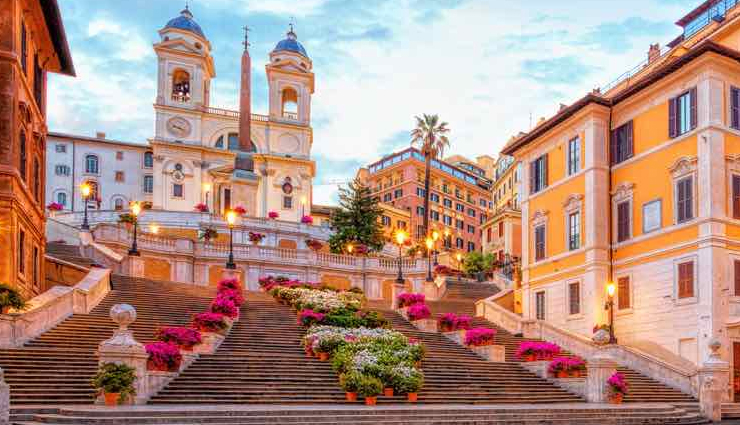
# Spanish Steps
The Spanish Steps, known as Scalinata di Trinità dei Monti in Italian, is a famous landmark in Rome, Italy. It is a monumental stairway that connects the Piazza di Spagna at the base with the Trinità dei Monti church at the top. The construction of the Spanish Steps was commissioned by Pope Innocent XIII and designed by the Italian architect Francesco de Sanctis. The construction was completed in 1725. The name "Spanish Steps" is derived from the fact that the nearby Spanish Embassy to the Holy See was situated at the base of the steps.
Design and Architecture:
The Spanish Steps consist of 135 steps divided into twelve flights. The stairway is made of travertine stone and is characterized by its gentle slope and unique butterfly design. At the top of the steps is the Trinità dei Monti church, which adds to the picturesque beauty of the area.
Piazza di Spagna:
The Piazza di Spagna, located at the base of the Spanish Steps, is a vibrant square that attracts locals and tourists alike. It is named after the Spanish Embassy and is known for its elegant buildings, luxury shops, and popular cafes. The square is often bustling with activity and serves as a meeting point for locals and visitors.
Trinità dei Monti Church:
Dominating the top of the Spanish Steps is the Trinità dei Monti church. This beautiful church, with its twin bell towers and impressive façade, was built in the 16th century and showcases Renaissance and Baroque architectural elements. Inside, visitors can admire stunning frescoes, sculptures, and religious artworks.
Panoramic View:
One of the highlights of visiting the Spanish Steps is the panoramic view of the surrounding area from the top. From the Trinità dei Monti church, visitors can enjoy breathtaking views of Rome, including the city's rooftops, domes, and historic landmarks.
Meeting Place and Leisure Spot:
The Spanish Steps have long been a popular meeting place for locals and a favorite spot for leisurely activities. Visitors can relax on the steps, enjoy a gelato or a coffee, and soak up the vibrant atmosphere. The steps are often adorned with flowers, adding to the charm and beauty of the area.
Events and Festivals:
The Spanish Steps have been a venue for various cultural events and festivals throughout history. Concerts, art exhibitions, and fashion shows have taken place on the steps, attracting people from all walks of life.
Visiting the Spanish Steps:
The Spanish Steps are open to the public and can be visited year-round. It is recommended to visit early in the morning or in the evening to avoid large crowds. The steps are particularly enchanting during spring when the azaleas bloom and create a colorful display.
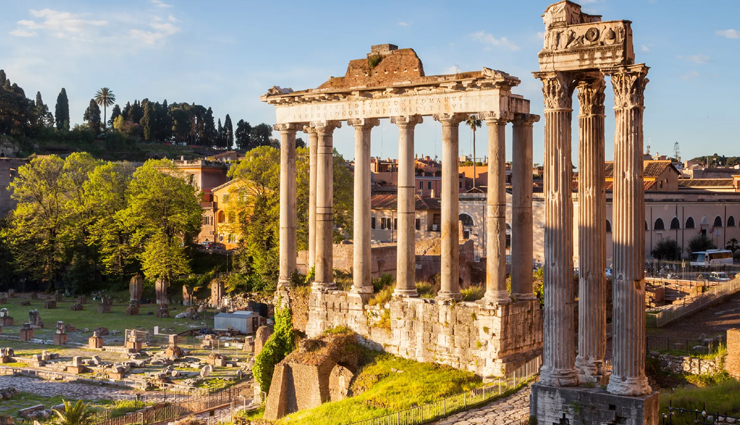
# Roman Forum
The Roman Forum, also known as the Forum Romanum in Latin, is an ancient archaeological site located in the center of Rome. The Roman Forum holds immense historical significance as it was the focal point of Roman civilization for centuries. It dates back to the 7th century BC and evolved over time, becoming the center of political, religious, and social activities in ancient Rome. The Forum witnessed numerous historical events, including triumphal processions, elections, public speeches, and commercial transactions.
Layout and Architecture:
The Roman Forum covers a rectangular area surrounded by ruins of ancient structures and temples. The layout of the Forum includes various important buildings and landmarks, such as the Basilica Julia, the Temple of Saturn, the Temple of Vesta, the Arch of Septimius Severus, and the Curia Julia (Senate House). These structures represent the architectural styles of different periods in Roman history.
Political and Social Functions:
The Roman Forum was the site of political activities and public gatherings. It was where the Roman Senate met, and political debates, trials, and discussions took place. It served as a marketplace where vendors, traders, and merchants conducted business. Additionally, the Forum hosted religious ceremonies and processions, providing a space for public worship and the display of religious rituals.
Monuments and Statues:
The Roman Forum was adorned with numerous monuments, statues, and honorary columns dedicated to emperors, generals, and other prominent figures. These impressive structures added to the grandeur and splendor of the Forum, reflecting the power and prestige of the Roman Empire.
Excavation and Preservation:
Over time, the ruins of the Roman Forum were buried beneath layers of sediment and debris. Extensive excavation and restoration efforts have been undertaken to uncover and preserve the ancient remains. Today, visitors can walk through the ruins and gain insights into the daily life and architectural achievements of ancient Rome.
Visiting the Roman Forum:
The Roman Forum is open to the public, allowing visitors to explore the fascinating ruins and experience the historical ambiance of ancient Rome. There are entrance fees, and guided tours are available to enhance the understanding of the site's significance. It is advisable to plan ample time for the visit, as there is much to see and learn.
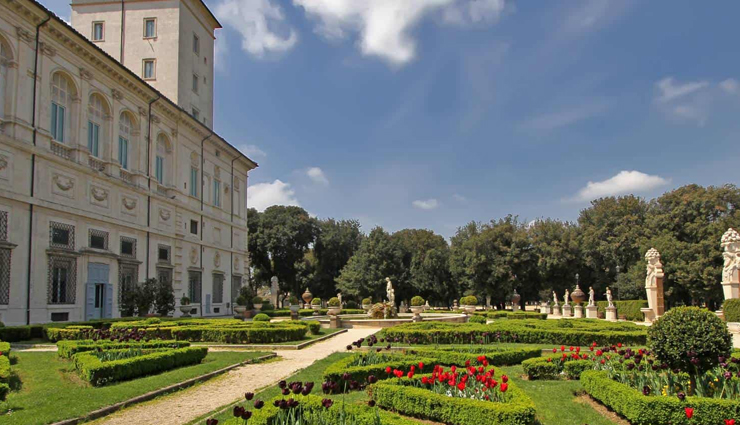
# Villa Borghese Gardens
The Villa Borghese Gardens, known as Villa Borghese in Italian, is a sprawling public park located in the heart of Rome. It is one of the largest green spaces in the city and offers a serene escape from the bustling streets. The Villa Borghese Gardens were originally part of the private estate belonging to the Borghese family, a prominent Italian noble family. In the 17th century, Cardinal Scipione Borghese transformed the estate into a magnificent garden with landscaped lawns, scenic pathways, and various architectural elements. In 1903, the park was opened to the public.
Size and Features:
Covering an area of approximately 80 hectares (148 acres), the Villa Borghese Gardens offer ample space for relaxation, recreation, and cultural activities. The park is home to a wide variety of trees, flowers, and plants, creating a lush and picturesque environment. It features beautifully manicured lawns, tranquil lakes, fountains, and several notable buildings and attractions.
Attractions and Points of Interest:
Galleria Borghese: Located within the gardens, the Galleria Borghese houses an exceptional collection of art, including masterpieces by renowned artists such as Caravaggio, Bernini, and Raphael. The gallery requires advance booking for entry.
Borghese Zoo (Bioparco di Roma): Situated within the gardens, the Borghese Zoo is one of the oldest zoos in Europe. It is home to a diverse range of animals from around the world and offers educational and entertaining experiences for visitors of all ages.
Pincio Terrace: The Pincio Terrace provides a panoramic viewpoint overlooking the Piazza del Popolo and the cityscape of Rome. It is a popular spot for strolling, enjoying a picnic, or simply taking in the breathtaking views.
Temple of Asclepius: This ancient temple replica is dedicated to the Greek god of medicine, Asclepius. It features a beautiful colonnade and offers a tranquil atmosphere for contemplation.
Casino dell'Aurora: This charming building, also known as the Casino Borghese, is an exquisite example of Renaissance architecture. It houses the visitor center for the Villa Borghese Gardens and provides information about the park and its attractions.
Recreational Activities:
The Villa Borghese Gardens offer a range of recreational activities for visitors. There are jogging and cycling paths, as well as areas for picnicking, sunbathing, and playing sports. Boat rentals are available on the park's lake, allowing visitors to enjoy a leisurely paddle on the water.
Cultural Events and Performances:
Throughout the year, the Villa Borghese Gardens host various cultural events, including art exhibitions, concerts, and theater performances. The park becomes a vibrant venue for artistic expressions and entertainment.
Visiting the Villa Borghese Gardens:
The gardens are easily accessible and are located near the Spanish Steps and Piazza del Popolo. Entry to the park is free, and visitors can explore at their leisure. However, certain attractions, such as the Galleria Borghese, require advance booking. It is advisable to bring comfortable shoes, as the park is quite expansive.

# Piazza Navona
Piazza Navona is a vibrant public square located in the historic center of Rome, Italy. It is renowned for its architectural beauty, lively atmosphere, and rich history. Piazza Navona sits on the site of the ancient Stadium of Domitian, which was built in the 1st century AD. The square takes its elongated shape from the original stadium's outline. Over the centuries, the square transformed into a vibrant social and cultural hub.
Architectural Highlights:
Piazza Navona is characterized by its stunning Baroque architecture. The square is surrounded by magnificent buildings and palaces, showcasing the artistic and architectural prowess of the 17th century. The most notable structures include:
Sant'Agnese in Agone: This grand Baroque church stands at one end of Piazza Navona. Designed by renowned architects Francesco Borromini and Girolamo Rainaldi, it is dedicated to Saint Agnes and features a beautiful façade and an ornate interior.
Palazzo Pamphili: Located on the square's west side, Palazzo Pamphili is an impressive palace that once belonged to the influential Pamphili family. It currently houses the Brazilian Embassy to the Holy See.
Fountain of the Four Rivers (Fontana dei Quattro Fiumi): Designed by Gian Lorenzo Bernini, this stunning fountain is the centerpiece of Piazza Navona. It depicts four river gods representing the Nile, Ganges, Danube, and Rio de la Plata, each symbolizing a different continent.
Fountain of the Moor (Fontana del Moro): Situated at the southern end of the square, this fountain features a central statue of a Moor wrestling with a dolphin. It was initially created by Giacomo della Porta and later modified by Bernini.
Fountain of Neptune (Fontana del Nettuno): Located at the northern end of the square, this fountain depicts Neptune, the god of the sea, surrounded by sea creatures. It was created by Giacomo della Porta and later embellished by Antonio Della Bitta.
Street Performers and Cafés:
Piazza Navona is a lively gathering place where locals and tourists come to socialize, relax, and enjoy the bustling atmosphere. The square is known for its vibrant street performers, artists, and musicians who entertain visitors with their talents. The outdoor cafés and restaurants that line the square offer a perfect spot to sit, sip a coffee, and soak in the vibrant ambiance.
Christmas Market and Events:
During the holiday season, Piazza Navona transforms into a festive wonderland. A traditional Christmas market fills the square, with stalls selling crafts, decorations, and delicious treats. The square also hosts various events, including live performances and nativity scene displays.
Visiting Piazza Navona:
Piazza Navona is easily accessible and located within walking distance of other famous landmarks in Rome. It is open to the public and free to visit. The square can get crowded, especially during peak tourist seasons, so it is advisable to visit early in the morning or in the evening to fully enjoy the experience.
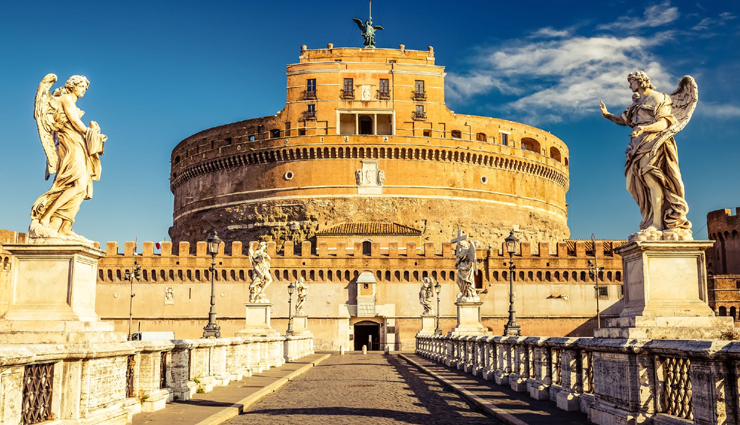
# Castel Sant'Angelo
Castel Sant'Angelo, also known as the Mausoleum of Hadrian, is a historic fortress located in Rome on the right bank of the Tiber River. Castel Sant'Angelo was initially commissioned by the Roman Emperor Hadrian as a mausoleum for himself and his family in the 2nd century AD. However, over the centuries, it served various purposes, including as a fortress, a papal residence, a prison, and a museum.
Architecture:
The fortress is an impressive example of Roman architecture. It features a cylindrical shape, which was unique for its time. The exterior is clad in travertine stone and adorned with decorative statues and reliefs. The top of the castle is crowned with a statue of an angel, giving it its name, which translates to "Castle of the Holy Angel."
The Angel's Bridge:
To reach the castle, visitors must cross the Ponte Sant'Angelo, also known as the Angel's Bridge. The bridge is adorned with ten beautiful angel statues, each holding various symbolic objects.
Papal Residence and Secret Passages:
During the Middle Ages, Castel Sant'Angelo served as a papal residence and fortress. Popes used it as a refuge during times of danger. The castle is famous for its hidden passageway, the Passetto di Borgo, which connects it to Vatican City. This secret passage allowed popes to escape in times of emergency.
The Prison:
For several centuries, Castel Sant'Angelo functioned as a prison. Notable figures were imprisoned here, including the notorious Italian painter and sculptor Benvenuto Cellini. The castle's prisons and dungeons can be visited, providing a glimpse into its dark and haunting history.
Museum and Art Collection:
Today, Castel Sant'Angelo is a museum that showcases a vast collection of historical artifacts and artwork. Visitors can explore various rooms and halls, including the papal apartments, the treasury, and the weapons room. The museum exhibits sculptures, paintings, military equipment, and historical artifacts from different periods.
Panoramic Views:
One of the highlights of visiting Castel Sant'Angelo is the breathtaking panoramic view it offers from its terrace. From this elevated vantage point, visitors can enjoy stunning views of Rome's historic cityscape, including the Vatican City, St. Peter's Basilica, and the Tiber River.
Visiting Castel Sant'Angelo:
Castel Sant'Angelo is open to the public, and visitors can explore its interior and outdoor areas. There is an entrance fee to access the museum and the castle. Guided tours are available for a more in-depth understanding of its history and architecture. It is advisable to check the opening hours and plan the visit accordingly.

# Trastevere
Trastevere is a charming neighborhood located on the west bank of the Tiber River in Rome Known for its narrow, winding streets, vibrant atmosphere, and bohemian vibe, Trastevere is a beloved destination for locals and tourists alike. Trastevere has a rich history that dates back to ancient Rome. Its name translates to "across the Tiber," indicating its location on the opposite side of the river from the city center. The neighborhood was traditionally home to working-class residents, artisans, and immigrants. Over time, it has evolved into a lively and eclectic area known for its distinctive character.
Authentic Roman Ambiance:
Trastevere exudes an authentic Roman ambiance with its narrow cobblestone streets, ivy-covered buildings, and charming squares. The neighborhood has retained much of its medieval character, providing a glimpse into Rome's past. As you explore the area, you'll encounter quaint trattorias, artisan workshops, and traditional Roman shops.
Piazzas and Gathering Places:
Trastevere is dotted with picturesque piazzas (squares) that serve as gathering places for both locals and visitors. Piazza Santa Maria in Trastevere is the neighborhood's central square and home to the stunning Basilica di Santa Maria in Trastevere, one of Rome's oldest churches. This square is a popular meeting point and a vibrant spot to enjoy a coffee or a gelato while taking in the lively atmosphere.
Lively Nightlife:
Trastevere comes alive at night, as the neighborhood is known for its vibrant nightlife. The streets are lined with bustling bars, cozy wine bars, and trendy nightclubs. Visitors can enjoy a drink and soak up the energetic ambiance, particularly in the area surrounding Piazza Trilussa.
Artistic and Cultural Hub:
Trastevere has long been a hub for artists, writers, and musicians. The neighborhood showcases a thriving artistic scene, with numerous art galleries, studios, and street art adorning the walls. The creative energy can be felt throughout the area, making it a haven for art enthusiasts.
Culinary Delights:
Trastevere is renowned for its culinary offerings. The neighborhood is home to a wide array of trattorias, osterias, and restaurants serving traditional Roman cuisine. Visitors can savor mouthwatering dishes such as pasta carbonara, cacio e pepe, and Roman-style pizzas. The narrow streets are also lined with bakeries, gelaterias, and local food markets, ensuring there's always something delicious to indulge in.
Exploring on Foot:
Trastevere is best explored on foot, allowing visitors to immerse themselves in its narrow streets and hidden corners. It's a neighborhood that encourages leisurely strolls, with surprises at every turn. Walking along the Tiber River promenade provides beautiful views of the cityscape, and crossing the bridges to reach Trastevere adds an extra touch of charm.





